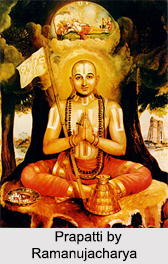 Prapatti as a direct means (upaya) to attain Moksha is one of the most important doctrines of Vaishnavism. According to the Visistadvaita Vedanta, Bhakti Yoga and Prapatti Yoga are the two important Sadhanas (means) for achieving the supreme spiritual goal. While the Upanishads have laid more emphasis on Upasana, which is the same as Bhakti Yoga, the Vaishnava treatises have accorded greater prominence to Prapatti. Both these means have been advocated by the Shruti and Smriti texts as alternative means for Moksha. These are intended for two different categories of individuals with different capacities and conditions of eligibility. Bhakti Yoga is a rigorous discipline and is restricted to certain class of individuals, whereas Prapatti is recommended as an easier path intended for all without any restriction of caste, creed and status of individuals. In view of this, the Vaishnava Acharyas, right from the time of Nathamuni have given preference to Prapatti and advocated it as the easier means of Moksha.
Prapatti as a direct means (upaya) to attain Moksha is one of the most important doctrines of Vaishnavism. According to the Visistadvaita Vedanta, Bhakti Yoga and Prapatti Yoga are the two important Sadhanas (means) for achieving the supreme spiritual goal. While the Upanishads have laid more emphasis on Upasana, which is the same as Bhakti Yoga, the Vaishnava treatises have accorded greater prominence to Prapatti. Both these means have been advocated by the Shruti and Smriti texts as alternative means for Moksha. These are intended for two different categories of individuals with different capacities and conditions of eligibility. Bhakti Yoga is a rigorous discipline and is restricted to certain class of individuals, whereas Prapatti is recommended as an easier path intended for all without any restriction of caste, creed and status of individuals. In view of this, the Vaishnava Acharyas, right from the time of Nathamuni have given preference to Prapatti and advocated it as the easier means of Moksha.
Etymology of Prapatti
The term "Prapatti" is derived from the root words "pra-pad". "Pad" means to move and "pra" implies in the best manner. In the context of upaya, the term implies total self-surrender to God as the sole refuge. A more appropriate term for Prapatti in the Sanskrit language is "Atma Niksepa" or "Bharanyasa", that is, to place the burden of protection of the self in the care of God. It is also known as "Saranagati", or seeking God as the sole refuge.
Siddhopaya and Saddhyopaya
Siddha means one who has been in existence even prior to the observance of the Sadhana and since the ever existing God is Himself the principal cause for attaining Him, He is Siddhopaya. If God is the upaya for Moksha, Bhakti and Prapatti are required to secure the grace of God. The individual souls have been deprived of the enjoyment of Brahman in the state of Moksha due to the karma which stands in the way of attaining God. The removal of this obstacle is possible only by the grace of God. Bhakti yoga and Prapatti serve the purpose of winning the grace of God. These are, therefore, described as Saddhyopaya, that is, the means to be observed for attaining God.
Nature of Prapatti
The nature of Prapatti is characterised by 6 essential components which make up this spiritual discipline. It is known as the Sadanga Yoga, which is similar in some respects to the Ashtanga Yoga of the Yoga system. The 6 components of Prapatti, as explained by Vedanta Desika on the basis of the Pancharatra treatises are:
1. Anukulya Sahkalpa: A determined will on the part of the aspirant to perform such acts would please God.
2. Pratikulya Varjana: To refrain from acts, which would cause displeasure to God.
3. Karpanya: The feeling of humility arising from the helplessness of an individual in resorting to other means of salvation.
4. Mahavisvasa: The absolute and unshakable faith in God as the sole protector.
5. Goptitva Varana: To make a request to God seeking His protection.
6. Atma Niksepa: Entrusting the burden of protecting the individual self to the care of God.
Each one of these constitutes an important component of Saranagati or Prapatti and bears ethical and theological significance.
Types of Prapatti
There are different types of Prapatti depending upon the way in which it is observed:
One can observe it by the recitation of the prescribed prayer with the help of a qualified preceptor (Acharya). This is known as "Uktinistha".
Alternatively, one may do it through the medium of an Acharya, who on behalf of the concerned individual performs Saranagati in the prescribed manner. This is known as "Acharya-Nistha".
There are also other modes of observance and the prescribed ritualistic procedure varies from one sect to the other even among the Sri Vaishnavas.




















